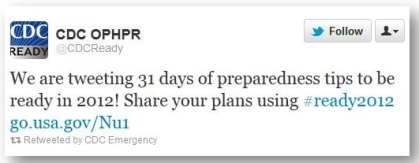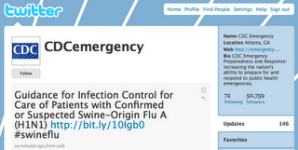After tornadoes tore across the Midwest this week, we were reminded once again that the impending arrival of spring means severe weather is on the way. But as it’s been shown through recent disasters, social media continues to play a large role in communicating within disaster-stricken communities and disseminating information to the public during times of crisis.
This past Tuesday after a tornado struck Harrisburg, Ill., the first thing I did was check Facebook to see how a friend had fared. She had updated her page that she had survived (even though her home had not) and within hours, friends were organizing care packages and making plans to help her out, all on her Facebook page.
During one of the largest tornado outbreaks last spring, social media allowed people to do just that: check in on one another – especially since phones lines were down – and in some instances, locate people who were injured and needed assistance.
So what does this mean for us?
How we should use social media if and when a natural disaster strikes:
First, check out your local government and emergency management groups. Are they on Facebook or Twitter? If they are, follow them. You never know when a tornado or other act of God may hit and if you can stay on your phone, it might be easiest to get your updates from the officials via mobile alerts.
An example of the significance of social media during disasters, the CDC has a “Social Media: Preparedness 101: Zombie Apocalypse” website to prepare people in the event of a “zombie apocalypse” or other possible disaster. The site includes a survival guide, suggested emergency kit contents, emergency plan instructions and a downloadable badge for social networking profiles.
Just as we advise clients in preparation of a crisis, we too should have a plan. How will you connect with family and friends? Is there an agreed-upon place to meet post-disaster? Having a kit with essential supplies can also be helpful. And speaking of supplies…
It sounds simple, but do you keep your cell phone and laptop fully charged? Make it a habit to plug them in every night before bed. And if you can, buy an extra charger to include in your emergency kit.
As seen during last summer’s East Coast earthquake, social media tools like Twitter will continue to be utilized to their full ability when the next disaster strikes. So remember, if you choose to do so, using social media can be a powerful tool to use during times of emergency, and could end up being your lifeline.
Filed under: Uncategorized | Tagged: cdc, crisis, crisis plan, disaster, disaster plan, dvl, emergency management, emergency plan, emergency preparedness, facebook, natural disaster, social media, social networking, tornadoes, twitter, when disaster strikes, Zombie Apocalypse | Leave a comment »



 NPR has reported two excellent yet contrasting stories this week regarding Twitter and the swine flu scare. The first points out the immediate nature of Twitter has facilitated an unnecessary panic by a misinformed public. The second details how the Center for Disease Control (CDC) has now embraced Twitter and is effectively using the tool to combat the misinformation and to establish online relationships with bloggers, journalists and public health officials. The CDC currently has over 50,000 subscribers following their updates. (Note: at the time of this post subscribers were at 50,000 – as of 7/21/09 subscribers are at more than 580,000)
NPR has reported two excellent yet contrasting stories this week regarding Twitter and the swine flu scare. The first points out the immediate nature of Twitter has facilitated an unnecessary panic by a misinformed public. The second details how the Center for Disease Control (CDC) has now embraced Twitter and is effectively using the tool to combat the misinformation and to establish online relationships with bloggers, journalists and public health officials. The CDC currently has over 50,000 subscribers following their updates. (Note: at the time of this post subscribers were at 50,000 – as of 7/21/09 subscribers are at more than 580,000)